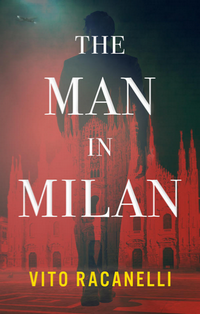Earlier this morning, I talked about the book, and now I get to give you a little taste—the opening paragraphs, I hope it hooks you the way it did me.
from Chapter 1 of The Man in Milan by Vito Racanelli (available from Polis Books)
Friday
In the gutter lay a man, face up, between two parked SUVs on Sutton Street. He wore a pale gray suit with impossibly thin pinstripes. It was Zegna, because I’d seen one on my partner, Detective Hamilton P. Turner. The suit was still in good shape, a testament to its workmanship, but the man was not.
I squatted and looked at him in the evening of an April day. I put on my latex and turned him gently. Our fashionable boy wore no tie and his pink shirt had a large red-brown blotch right where his heart used to beat. His suit was ruined in the back, an exit hole right through the trapezius. That’s what the coroner’s report would probably say.
He was about six feet, one inch. Skinny, with fine brown hair, blue- gray eyes. glauco, they say in Italian, which is what the body turned out to be. My grandfather was called Glauco for his eyes. This guy was good looking. Once. No sign of a struggle. Two wounds: a dime-sized hole punched through the back of the head and one more straight into the chest—probably the second shot as he lay prone—to make sure he stayed all the way dead. Below, burrowed halfway into the asphalt, was a slug.
The blues who’d found him already radioed for the NYPD photogs and CSU.
I walked back to my car to call my partner, who’d hadn’t told me why he couldn’t come along to the party. “I’m good,” I said to Turner. “You’re missing a beautiful spring evening in New York City, marred only by one dead body.”
His voice crackled over the radio: “Just the one? Gonna rain later. Meet you back at the precinct, Paolino,” Turner said.
I tossed the receiver back into our Crown Vic’s front seat and walked back to the body. Turner liked to call me little Paul because I was taller than him.
The photogs showed up and cordoned off the area around the body.
“Any other bodies, Detective Rossi?” the photographer asked me.
“I told you, one. Why does everyone think there’s more than one?” I said.
“Yeah, but you know, sometimes you think there’s one and then other bodies just start showing up when you look around. They’re like rabbits.”
I smiled at our photographer, Joe Rinn. He had a nice sideline doing weddings. “You never tell those brides what you do, do you? That you flash dead bodies all day. That your work graces medical school books about fatal wounds?”
“Nah,” he said, smiling back at me, then turning to the job at hand. “I tell ’em I’m an artist.”
I stood back and let the artist work. I tugged my right ear, tilted my head to get another look at this guy, and wondered what this poor fucker had done to deserve a dog’s death.
Rinn circled the body like a vulture. “The geeks’ll be here in a minute. And hey, a Post guy is comin’, too. He asked me to keep the bodies fresh.”
“A body. One body. We’ll try to oblige, but if the fourth estate doesn’t show in time, tough,” I said.
After they took the first set of photos, the CSU geeks began. Hair, blood, and nail samples. They scraped his jacket, pants, and shirts with tape to pick up foreign elements, like someone else’s hair or blood.
I looked around to figure some possible MOs. There was a small service alcove down a few steps and a few feet away. Our hunter knew his rabbit’s habits. Maybe tailed him for a few days. He waited in the alcove and calmly skipped up to the victim as he walked between a Range Rover and an Escalade. That gave the shooter some tall cover, and then he did him. Bang. Bang. Or rather Ping, Ping, with a silencer. The killer had probably taken care after the first shot to lay the body down, so that they were partially obscured, on Sutton near 51st. And that’s when he—or they—popped him a second time. His head, inches from the curb, was near enough that his blood had drained into the sewer nearby. Just when you think you’ve seen it all.
The body came conveniently with docs, a small black address book and an Italian identity card wrapped in a soft, dark brown leather case— Gaitano Muro, forty-six years old and a Milan address, so immediately I thought Mafia. Even the stupidest perp knows not to leave docs in a fixit job. The killer must have been spooked immediately and had to run. This was a botched execution. Two kill shots to rob someone? Not likely.
The address book had names and phone numbers but little else. No addresses. The ID was diplomatic, Capo Servizio something or other, Consolato Generale della Repubblica Italiana, it said, with an embossed little star inside an olive branch and a mechanical gear wheel. My Italian wasn’t bad thanks to my grandfather. Muro was a diplo and Signore Muro from Milan came all the way to New York City and found unexpectedly that this late April evening would be the least lucky night he was ever to have, and he was dropped in the gutter on Sutton St. I suppose there are worse streets to die on.
I’d bet it wasn’t the way he thought it would go. Nobody ever does.
.
Excerpted The Man in Milan Copyright © 2020 by Vito Racanelli Reprinted with permission from the author. All rights reserved
Read the rest in The Man in Milan by Vito Racanelli to see what happens from here.
Thanks to Polis Books, Vito Racanelli and Saichek Publicity for this excerpt!




